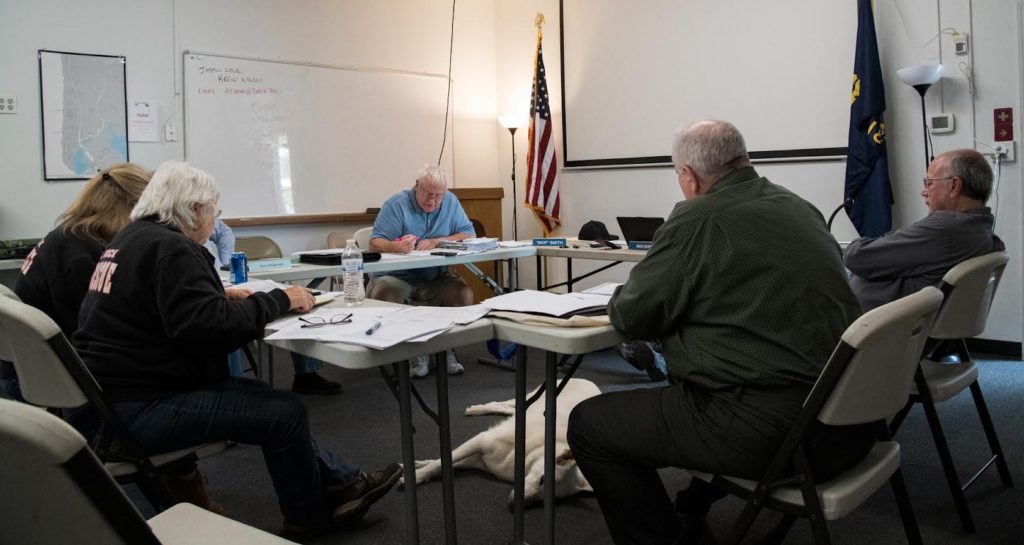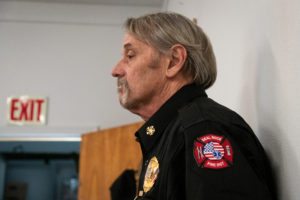
By JORDAN ESSOE/YachatsNews.com
SEAL ROCK – Facing staffing deficits, a tight budget, unexpected equipment repairs and external criticism, Seal Rock Rural Fire Protection District is accelerating its plan to deploy an emerging unit of volunteer responders.
Since March, Seal Rock has lost all four of its full-time paid firefighters. The last to leave, Derek Udoutch has taken a new job and will be gone by the end of the month.
There remain paid responders in rotation who fill shifts at Seal Rock, but all of them – currently seven in total – are temporary employees who come from outside areas, sometimes as far away as Portland or San Diego.
While admitting the timing of Udoutch’s departure couldn’t be worse, Fire Chief Will Ewing is confident that the department is “stronger there than they’ve been in a long time,” and in a good position to continue to improve.
Since the beginning of his tenure at Seal Rock last October, the goal of a new board and the new chief has been to transition the staffing model from one that relies solely on paid firefighters to one that significantly offsets them with volunteer responders.
This is a departure from the philosophy of other Lincoln County fire departments or districts, which say changing demographics, the changing nature of work and increased training requirements for volunteers make it very hard to recruit and retain them.

But Ewing believes any staffing model that relies principally on paid workers can only work well in larger metropolitan areas with more robust financial resources and cannot succeed long-term in small towns where operating costs continue to rise at a faster rate than local taxes and levies.
Ewing also predicts that within the next two decades, Seal Rock, Central Oregon Coast Fire & Rescue, and the Yachats Rural Fire Protection District will all be unified under one central organization “or we’re going to have districts that go out of business.”
“When I got here in October, I had four paid guys. We only had funding for three,” said Ewing. “This is all about building capacity. We are slowly but surely building capacity. And we’re doing it with non-expensive labor called volunteers. Because as a taxpayer, I firmly do not believe that the levies will last forever. Sooner or later, you’re going to lose your levy. When you lose your levy, you lose your paid people.”
The idea is that volunteers backstop that situation like what happened June 7, when two calls came in during a shift where there were no fill-in Seal Rock responders and no volunteers available.
Ewing, 65, and a trained medic, had worked more than 24 hours straight and needed to go home to rest. There was no one available to follow his shift.
“I spent the night, but had to leave Wednesday at 4:30 because my eyes were falling out. I hadn’t slept,” said Ewing. “We had – bam, bam – two calls that didn’t go because I didn’t have a back-up plan for me leaving. So we had no coverage on that day. That’s my bad, it’s on me completely. Central Coast came out and bailed us out.”
Ewing said that the outcome was OK because of the mutual aid agreements that require neighboring departments to answer calls. Ewing said there wasn’t much else he could have done at the time — he couldn’t get any other paid responders on shift, and couldn’t work longer himself without rest.
But that can lead to friction between departments if one agency declines to staff itself adequately and rely too much on mutual aid from neighbors, which also may struggle or have to call in volunteers if there are multiple calls.
Ewing says every small department can run into this problem from time to time, but his plan is to have enough volunteers to prevent it from happening at Seal Rock.
“What we’ve done since last Tuesday is talk to the volunteers to step up and cover duty shifts when they don’t have coverage from paid staff,” Ewing said. “With the caveat that if it’s a medical call they wait in the area until an ambulance gets on the scene.”
Nine of Seal Rock’s current volunteers are working on their Emergency Medical Response training. Once they are EMR-certified, restrictions on their response protocol will be lifted.
Seal Rock has recently added five new volunteers, bringing their current total of active volunteers to 11, including board secretary Mike Burt. Ewing’s goal is to have 20 volunteer responders supporting the department by the end of the year.
With 20 or more volunteers, he believes the department will be able to go on to two calls at the same time and still have reserve.
“We won’t have two people sitting on one engine to do one thing,” he said. “We’ll have multiple people that can go in multiple vehicles to do multiple things.”
Ewing said the goal is to also find volunteers who want to help, but do not want to fight fires. In addition to emergency responders, they are also looking for people who can be part of incident management teams, help with maintenance of equipment and vehicles, provide food services, assist in communication with the public, and many other areas.
The plan is based on the model he successfully executed at Toledo Fire & Rescue, where he organized a deep bench of 50 volunteers, half of which were emergency responders with firefighting and medical training, and half of which were volunteers who worked in a supportive or administrative capacity.
In Seal Rock, they are calling the emergency responders “9-1-1” volunteers and the support responders “10-1-1” volunteers.
One difference that makes Seal Rock a more challenging community to
recruit volunteers of any kind is its smaller, older population. The median age in Seal Rock is over 60. Toledo is home to the 420-employee Georgia-Pacific paper mill, has 2½ times the population of Seal Rock, and has a median age in the mid-30s.
New budget for equipment repairs, hiring
The Seal Rock Fire District board Thursday unanimously adopted a general fund budget of $760,000 for fiscal 2022-23 beginning July 1, which will give the district more money to recruit new paid staff.
It’s a very competitive market for finding firefighters. Most other departments, some of which can pay more and offer better benefits than Seal Rock, are having trouble recruiting. Ewing acknowledged “that’s going to be a problem,” suggesting the best he could hope for might be one new full-time responder.
“I might have two temporary people that pull 24-hour shifts combined with one 40 hour-a-week person. I’m not sure how I’m going to land on this.”
Seal Rock has also been dealing with equipment problems.
Its main fire engine sometimes won’t start. Ewing described the engine as unreliable, starting nine times out of 10, but fully functional when it does start.
He isn’t able to fix it until July, once the new fiscal year begins, and in the meantime says he will rely on their brush truck and potentially lean on Seal Rock’s mutual aid agreements.
Sometime within the next two weeks they will be getting a second, used engine on loan from East Lincoln Fire Department in Eddyville. Ewing has worked out an intergovernmental agreement with East Lincoln that will allow Seal Rock to use and maintain the engine for two to three years while the other department builds a new station to house it.
In addition to the engine trouble, the Bayshore-based fire rescue truck was damaged when it parked too close to an active fire and two headlights melted. “They were $500 a piece to replace,” said Ewing, “but that stuff happens.”
A water tender also stopped working, but new batteries resolved the issue.
Board praises chief
Ewing received a very positive three-month evaluation by the board Thursday, expressing confidence in the district’s future.
“Chief Ewing tackled the tricky, complicated, negative financial situation inherited by this board with skill and a sense of urgency,” said board treasurer Paul Rimola. “I firmly believe that the district would have been in serious trouble if not for the leadership of Chief Ewing.”
After August, many of the new volunteers will be more fully trained, but there is a long way to go.
For staffing shifts, Ewing’s seven paid responders are not always available.
“And they are all Firefighter 1 and EMTs,” said Ewing. “I’m meeting that requirement because that’s what was required across the bridge to meet the mutual aid agreement. So I’m trying to honor that, but it’s hard.”
Ewing says managing the staff will continue to be stressful until he gets a large enough volunteer force recruited and certified.
To increase fire safety for the community, he looks forward to a time when he might even be able to use the volunteers to double the staffing on holidays like July 4th or during peak fire season.
- Jordan Essoe is a Waldport-based freelance writer who can be reached at alseajournal@gmail.com


